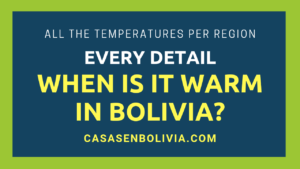Last Updated on February 15, 2025
Bolivia experiences its hottest season of the year simultaneously across the entire country. This period occurs at the end of the year and is characterized by very high temperatures, particularly in October, November, and December. Sometimes, August and September can also be quite hot, but the actual intensity depends on the specific climatic region.
The hottest time of year in Bolivia consistently spans from October to December, and in some cases, includes September and January. During this period, Altiplanic regions experience average maximum temperatures of 66°F and absolute maximum temperatures of 74°F. Temperate regions see averages of 79°F and absolute maximums of 89°F, while tropical regions reach averages of 89°F and absolute maximums of 99°F.
In this article, we’ll discuss all the details related to temperatures and weather during Bolivia’s hottest season. You’ll find precise figures and forecasted temperatures for this period, categorized by different climatic regions, cities, and seasons, along with other relevant information. We are Bolivian real estate experts (you can visit our Bolivian real estate website).
Bolivia’s Hottest Time of Year
Bolivia experiences its hottest time of year consistently across all regions. Regardless of whether you’re in the western, eastern, or central part of the country, the hottest period occurs at the same time, specifically *at the end of the year, between October and December*.
However, the intensity of heat you’ll experience within the country varies significantly depending on the climatic region. There are three distinct climatic regions in total:
- The Altiplanic West (*Mean max temp: 66°F. Absolute max temp: 74°F* from October to December). Generally very cold, reaching comfortable temperatures during peak heat. The main cities located in this region are:
- La Paz
- El Alto
- Oruro
- Potosí
- The Temperate Center (*Mean max temp: 79°F. Absolute max temp: 89°F* from October to December). Generally mild temperatures, but quite hot during this season, still reaching comfortable levels during heat peaks. The main cities located in this region are:
- Cochabamba
- Sucre
- Tarija
- The Tropical East (*Mean max temp: 89°F. Absolute max temp: 99°F* from October to December). Very warm, tropical, and Amazonian, sometimes reaching uncomfortably high temperatures during heat peaks. The main cities located in this region are:
- Santa Cruz de la Sierra
- Trinidad
- Cobija
The Hottest Time in Bolivia’s Three Main Climatic Regions
As mentioned earlier, Bolivia has three distinct climatic regions, *each experiencing significantly different temperatures* during the hottest time of year. You can see the specific figures in the following table.
| (Mean max: / Abs max:) | August | September | October | November | December | January | February |
| Altiplanic cold West | 62°F / 69°F | 64°F / 73°F | 66°F / 75°F | 67°F / 76°F | 66°F / 72°F | 63°F / 73°F | 62°F / 71°F |
| Rugged tempered Center | 76°F / 88°F | 77°F / 91°F | 79°F / 94°F | 79°F / 87°F | 79°F / 85°F | 77°F / 85°F | 76°F / 86°F |
| Tropical hot East | 87°F / 98°F | 88°F / 99°F | 89°F / 100°F | 89°F / 99°F | 88°F / 97°F | 88°F / 96°F | 87°F / 95°F |
Source: https://senamhi.gob.bo/index.php/clima
| (Mean max: / Abs max:) | August | September | October | November | December | January | February |
| Altiplanic cold West | 17°C / 21°C | 18°C / 23°C | 19°C / 24°C | 19°C / 24°C | 19°C / 22°C | 17°C / 23°C | 17°C / 22°C |
| Rugged tempered Center | 24°C / 31°C | 25°C / 33°C | 26°C / 34°C | 26°C / 31°C | 26°C / 29°C | 25°C / 29°C | 24°C / 30°C |
| Tropical hot East | 31°C / 37°C | 31°C / 37°C | 32°C / 38°C | 32°C / 37°C | 31°C / 36°C | 31°C / 36°C | 31°C / 35°C |
Source: https://senamhi.gob.bo/index.php/clima
1) The Altiplanic West
This is Bolivia’s coldest climatic region, located in the Altiplano, a vast, high-altitude plateau that typically experiences freezing temperatures during winter. It’s difficult to experience weather warm enough to wear light clothing or be comfortable at night in this region.
However, this situation changes significantly during the region’s hottest period. During this time, typically between October and December, you’ll feel warm enough to wear just a t-shirt or shirt and light pants or jeans during the day. At night, temperatures are not excessively cold, allowing you to feel comfortable in reasonably light clothing.
The main cities located in this region of Bolivia are:
- La Paz
- El Alto
- Oruro
- Potosí
In these cities, and throughout this region in general, you’ll feel quite comfortable during the day and experience pleasantly warm temperatures at night during the hottest time of year.
This contrasts sharply with the winter or cold season, when you’ll need to wear heavy clothing and may even experience freezing temperatures in many instances.
2) The Rugged, Temperate Center
This central corridor traverses Bolivia from north to south and has been formed by the Andes Mountain range. This region serves as a transition zone between the very cold, high-altitude Altiplanic West and the tropical, low-elevation East. Consequently, this part of Bolivia is characterized by mountains, hills, valleys, and canyons.
Within three very large valleys in this region, three of Bolivia’s main cities are located, where the weather is generally mild, even during the warmest period of the year.
The principal cities located in this region of Bolivia are:
- Cochabamba
- Sucre
- Tarija
During the hottest time of year, this region and its cities experience quite warm temperatures, *but they remain manageable and comfortable during the day*. At night, you’ll feel very refreshed and pleasantly warm.
Indeed, *this is the region of Bolivia with the most favorable climate for living*, as throughout the entire year, it’s common to experience a very mild climate with minimal variation – not too hot and not too cold. This doesn’t change significantly during the warmest period of the year. However, these cities do carry *other risks of contracting endemic diseases*, as you can read in this guide.
3) The Tropical East
As this is a vast *tropical and Amazonian* region of Bolivia (in fact, it’s the largest part of the country), temperatures are very hot almost all year round. It becomes even hotter during the hottest time of the year, between October and December, and sometimes including January in this area.
There, *you’ll feel as though you’re in a Caribbean country*. During the warmest period of the year, temperatures can sometimes be quite difficult to manage and uncomfortable. During this time, people typically avoid excessive sun exposure and make every effort to stay hydrated.
Cambas (the term for inhabitants of this part of the country) are very accustomed to living in these warm temperatures, which can average around 100-105°F, with 90%-100% humidity, during the hottest time of year. However, for a foreigner or someone unaccustomed to these temperatures, *it can be quite challenging to feel comfortable* and perform normal daily activities.
The principal cities located in this region of Bolivia are:
- Santa Cruz
- Trinidad
- Cobija
During *the warmest time of year*, of these three cities, Santa Cruz will be the coolest, only about 2-3°F colder, but still reaching around 100°F during the day and around 85°F at the coolest part of the night. Trinidad and Cobija will be slightly warmer, even reaching 105°F during the day.
It’s worth noting that in this region of Bolivia, high temperatures are not accompanied by dry winds. Instead, you’ll feel very humid all the time, making it more difficult to cool your body.
There is a **significant risk of heatstroke in this region** of Bolivia and its cities during the hottest time of year (October to January). Therefore, in general, be very cautious about this possibility, as on some days, temperatures can even reach 110°F.
The Extremely Hot Gran Chaco Region
Another fact you need to know is that in the tropical East of Bolivia, at the very south of the country, there is an area called the Gran Chaco region. Here, primarily from August to December, *extremely high temperatures are experienced*, reaching even 115°F in some cases.
This region is also where some of the highest historical temperatures in South America have been recorded (116.6°F or 47°C, 2014).
No major Bolivian cities are located in the Gran Chaco region, but there are several towns (Yacuiba, Puerto Suares, Villa Montes) and some tourist destinations. Temperatures there during the hottest time are accompanied by very dry winds and overall dry weather. *Be very cautious of heatstroke and dehydration when in this part of Bolivia*.
If you’d like to learn more about this place and all the towns and tourist locations within it, please visit our dedicated guide here: The hottest places of Bolivia: A complete overview.
The Hottest Time in Bolivia’s 10 Principal Cities
Now, we’ll examine the monthly temperatures in the country’s principal cities during the hottest time of year.
Depending on their location, some major cities have very similar average temperatures during the warmest period of the year, but they also differ significantly from other cities located in different climatic regions, as shown in the table below.
| (Mean max: / Abs max:) | August | September | October | November | December | January | February |
| La Paz | 64°F / 74°F | 66°F / 77°F | 68°F / 79°F | 69°F / 78°F | 68°F / 74°F | 66°F / 79°F | 64°F / 72°F |
| El Alto | 58°F / 64°F | 59°F / 68°F | 59°F / 70°F | 61°F / 69°F | 60°F / 66°F | 57°F / 68°F | 57°F / 64°F |
| Cochabamba | 80°F / 87°F | 81°F / 90°F | 82°F / 97°F | 83°F / 90°F | 81°F / 88°F | 79°F / 88°F | 79°F / 86°F |
| Santa Cruz | 83°F / 95°F | 84°F / 97°F | 87°F / 98°F | 88°F / 97°F | 87°F / 97°F | 88°F / 97°F | 86°F / 96°F |
| Oruro | 63°F / 66°F | 65°F / 72°F | 68°F / 75°F | 70°F / 78°F | 68°F / 77°F | 65°F / 77°F | 65°F / 74°F |
| Potosí | 64°F / 72°F | 65°F / 75°F | 68°F / 77°F | 68°F / 77°F | 66°F / 72°F | 63°F / 68°F | 63°F / 72°F |
| Sucre | 72°F / 82°F | 73°F / 83°F | 75°F / 86°F | 74°F / 81°F | 73°F / 79°F | 72°F / 77°F | 70°F / 79°F |
| Tarija | 77°F / 95°F | 78°F / 99°F | 81°F / 99°F | 81°F / 91°F | 82°F / 88°F | 81°F / 91°F | 80°F / 92°F |
| Trinidad | 88°F / 98°F | 89°F / 99°F | 90°F / 100°F | 90°F / 100°F | 89°F / 97°F | 88°F / 95°F | 88°F / 94°F |
| Cobija | 90°F / 100°F | 90°F / 101°F | 91°F / 101°F | 88°F / 100°F | 87°F / 97°F | 88°F / 97°F | 88°F / 96°F |
Source: https://senamhi.gob.bo/index.php/clima
| Winter (July to September) | Spring (September 21st to December 20th) | Summer (January to March) | |||||
| (Mean max: / Abs max:) | August | September | October | November | December | January | February |
| Altiplanic cold West | 17°C / 21°C | 18°C / 23°C | 19°C / 24°C | 19°C / 24°C | 19°C / 22°C | 17°C / 23°C | 17°C / 22°C |
| Rugged tempered Center | 24°C / 31°C | 25°C / 33°C | 26°C / 34°C | 26°C / 31°C | 26°C / 29°C | 25°C / 29°C | 24°C / 30°C |
| Tropical hot East | 31°C / 37°C | 31°C / 37°C | 32°C / 38°C | 32°C / 37°C | 31°C / 36°C | 31°C / 36°C | 31°C / 35°C |
Source: https://senamhi.gob.bo/index.php/clima
La Paz, El Alto, Oruro, and Potosí
These four cities are located in Bolivia’s cold Altiplanic region (known as the Altiplano), so they share similar temperatures throughout the year, *including during this hottest period*.
As you can see, El Alto, Oruro, and Potosí cities behave *almost identically* during the hottest season, experiencing similar temperatures at the same time. *However, La Paz is slightly warmer*, though not warm enough to be considered a temperate city.
During the warmest period of the year in La Paz, between October and December, it’s typically *warm enough to be outdoors wearing just a shirt and light pants or jeans* during the day. At night, the temperatures aren’t excessively cold, allowing you to feel comfortable wearing normal clothing.
However, in the other three cities, *even during the hottest months, it’s necessary to wear more than just a shirt and thin pants or a jacket during the day*. At night, you’ll still need to wear thick clothing to feel comfortable and warm.
Cochabamba, Sucre, and Tarija
These three cities are situated in three very large valleys within the rugged corridor that traverses Bolivia from north to south. These valleys have a moderate elevation, low enough to allow for warmer, mild temperatures.
As shown in the table above, *Sucre is slightly cooler throughout the year*. During the hottest time, it has warm temperatures that make you feel comfortable during the day and refreshed at night. Cochabamba and Tarija have very similar climates.
In some cases, or on very few days, temperatures in these cities can rise significantly, making you feel as though you were in a tropical location, with excessive heat. *However, this doesn’t occur frequently, and you’ll rarely experience extremely high temperatures in these cities*.
In general, these three cities have the most balanced and temperate climates in Bolivia. As mentioned earlier, this situation doesn’t change significantly during the hottest time of year. However, these cities do carry *other risks of contracting endemic diseases*, as discussed in this guide.
Santa Cruz, Trinidad, and Cobija
These three cities experience hot temperatures throughout the year. Residents are accustomed to this consistently warm weather. They generally tolerate the constant heat, humidity, and frequent rainfall.
During the hottest period of the year, temperatures in these three cities *rise even further*, *often exceeding normal body temperature* during the day. Even at night, you’ll still feel warm. However, as mentioned, the local population is generally used to it.
The table indicates that Santa Cruz remains relatively cooler throughout the year, but it still experiences very warm temperatures during the hottest period, often exceeding 103°F. The other two cities experience even higher temperatures, with some days reaching over 105°F during the day and remaining above 90°F at night.
These three cities, and this region in general, experience very high temperatures at the end of the year, *often accompanied by 95% to 100% humidity*, making it more challenging for the body to cool down. This combination of heat and humidity can lead to severe dehydration and even heatstroke, so exercise extreme caution.
Whenever you’re in these three cities during this time of year – between October and December, and sometimes including September and January – if the weather becomes excessively hot, prioritize staying well-hydrated and finding shade for protection.
Bolivia’s Hottest Seasons
In Bolivia, across all regions, the hottest period of the year *consistently occurs during the same seasons*:
- All of spring (Always). This spans from September 21st to December 20th *and is indeed the hottest season in Bolivia*.
- The end of winter (Usually). This spans from June 21st to September 20th. During September, it becomes quite hot throughout the country, and in some years, this temperature increase can extend into August.
- The beginning of summer (Usually). This spans from December 21st to March 20th. During January, temperatures across the country begin to decrease again, but in some cases, very high temperatures can persist into February.
| Winter (July to September) | Spring (September 21st to December 20th) | Summer (January to March) | |||||
| (Mean max: / Abs max:) | August | September | October | November | December | January | February |
| Altiplanic cold West | 62°F / 69°F | 64°F / 73°F | 66°F / 75°F | 67°F / 76°F | 66°F / 72°F | 63°F / 73°F | 62°F / 71°F |
| Rugged tempered Center | 76°F / 88°F | 77°F / 91°F | 79°F / 94°F | 79°F / 87°F | 79°F / 85°F | 77°F / 85°F | 76°F / 86°F |
| Tropical hot East | 87°F / 98°F | 88°F / 99°F | 89°F / 100°F | 89°F / 99°F | 88°F / 97°F | 88°F / 96°F | 87°F / 95°F |
Source: https://senamhi.gob.bo/index.php/clima
| Winter (July to September) | Spring (September 21st to December 20th) | Summer (January to March) | |||||
| (Mean max: / Abs max:) | August | September | October | November | December | January | February |
| Altiplanic cold West | 17°C / 21°C | 18°C / 23°C | 19°C / 24°C | 19°C / 24°C | 19°C / 22°C | 17°C / 23°C | 17°C / 22°C |
| Rugged tempered Center | 24°C / 31°C | 25°C / 33°C | 26°C / 34°C | 26°C / 31°C | 26°C / 29°C | 25°C / 29°C | 24°C / 30°C |
| Tropical hot East | 31°C / 37°C | 31°C / 37°C | 32°C / 38°C | 32°C / 37°C | 31°C / 36°C | 31°C / 36°C | 31°C / 35°C |
Source: https://senamhi.gob.bo/index.php/clima
Spring is the Hottest Season in Bolivia
As you can see, spring throughout Bolivia is very hot. Indeed, summer in our country is not the hottest season; *instead, it’s spring that holds this distinction*.
Spring in Bolivia occurs at the end of the year. During this season, in cold cities like La Paz, people begin to behave as if they were in a temperate or even tropical city. However, in tropical cities like Santa Cruz, tourists, and in many cases, local residents, start to feel very uncomfortable and excessively hot during this time.
Finally, in temperate cities like Cochabamba or Sucre, *temperatures during this season remain manageable*, but there are other hidden health risks, such as Chagas disease, which we discuss in another article (see the link for more information).
Conclusions:
In this article about Bolivia’s hottest period of the year, you’ve learned that it occurs simultaneously across the entire country, consistently at the end of the year, between October and December, and in some cases, including September and/or January.
You’ve also seen that the intensity of heat you’ll typically experience during the hottest time of year depends significantly on the climatic region. If you’re in a cold city or region like La Paz or the Altiplano, this period will be warm enough to be comfortable, with average maximum temperatures of 66°F and absolute maximum temperatures of 74°F.
Furthermore, if you’re in a temperate region or city like Cochabamba, you’ll experience quite warm temperatures that rarely become uncomfortable. Most of the time, you’ll feel comfortable with the level of heat, reaching average maximum temperatures of 79°F and absolute maximum temperatures of 89°F.
However, if you’re in a very hot tropical city or region like Santa Cruz, you may, in some cases, feel overwhelmed by the heat during the hottest time of the year. This sometimes requires you to be very mindful of your health status to prevent dehydration or heatstroke. In these locations, average maximum temperatures reach 89°F, and absolute maximum temperatures reach 99°F.
Finally, you’ve learned that spring is the hottest season in Bolivia, occurring from September 21st to December 20th, and in many cases, it also includes the end of winter and the beginning of summer. You’ve also seen that some towns and tourist destinations in the Gran Chaco region are extremely hot, sometimes reaching 115°F during the hottest time of year.
We hope this information has been helpful. If you’d like to learn all the details about the climate in Bolivia, including information about warm and cold places within the country, please visit our definitive guide here: How is the climate in Bolivia? A full overview.
CasasenBolivia.com, information on living, working, investing, and traveling in Bolivia.








